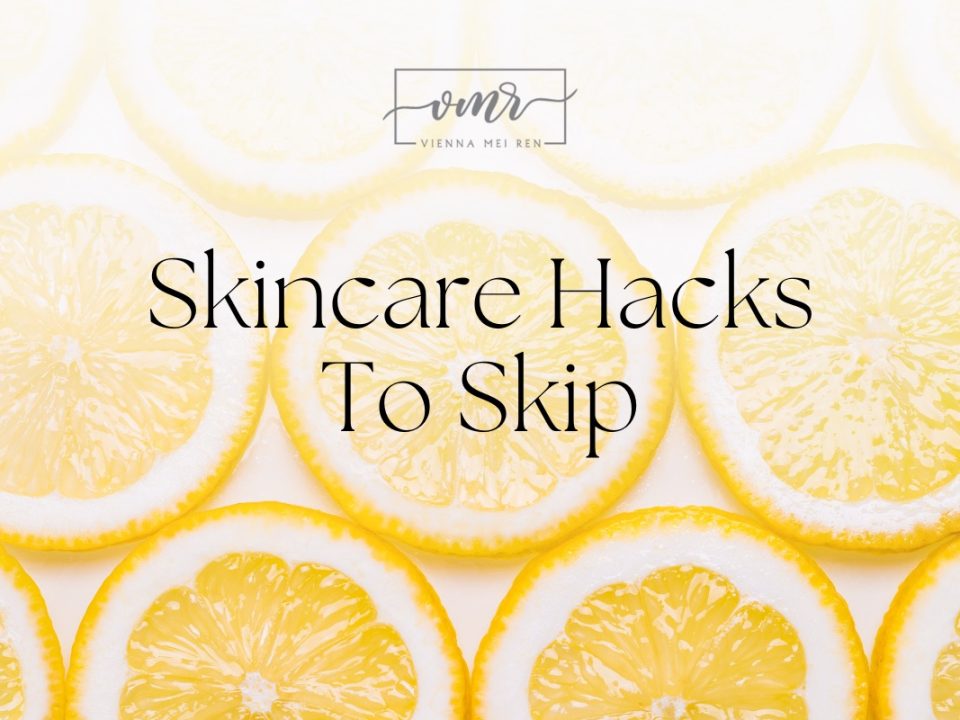
Air Pollution and Your Skin
April 29, 2025
6 Surprising Habits That Could Be Sabotaging Your Skin
June 24, 2025
5 Everyday Herbs That Love Your Skin
So many of the skincare formulas we love harness the power of potent botanicals, plants that brighten, firm, and smooth your skin naturally. But while some of these ingredients come from far corners of the world, others are probably growing in your garden right now!
That’s right— some of the most effective skin-rejuvenating herbs are everyday favourites that can be found in your kitchen or backyard. They’re easy to grow, easy to find, and bursting with beauty-boosting benefits.
Today we’re spotlighting a few of our favourite skin-loving herbs and how to use them in simple DIY, at-home rituals to boost your glow. These are plants you can easily grow or find at your local market.
Read on to learn how to nourish your skin the natural way, with plant-powered goodness!
Best Everyday Herbs to for Healthy Skin
5 Common Herbs and How to Use Them to Boost your Glow
Plants are some of our skin’s best allies— rich in nutrients, antioxidants, and soothing compounds that help support naturally radiant skin.
These everyday herbs are packed with skin-loving benefits. Think glow-boosting, pore-tightening, and calming your complexion.
Here are 5 easy-to-find herbs for happy, healthy skin, plus easy, DIY ways to use them at home:
1. Rosemary (Salvia rosmarinus)
Brightens and Refreshes
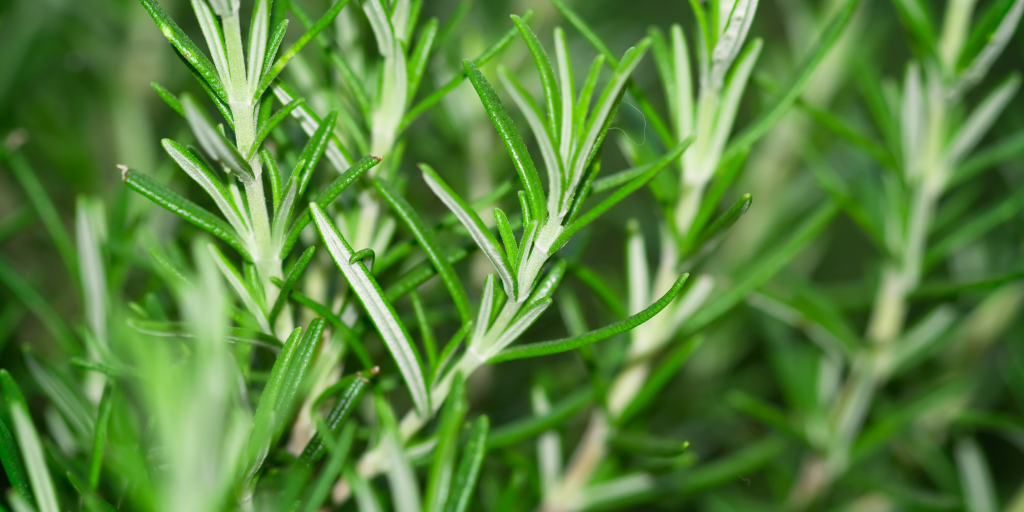
You may know this herbal hero from the kitchen, but did you know it can also boost your glow?
Rosemary has been shown to support circulation, which is essential for radiant skin. Better blood flow means more oxygen and nutrients delivered to your skin cells, resulting in a visibly brighter, livelier complexion and even reducing under-eye bags.
DIY Ritual: Rosemary Facial Steam
A quick, spa-worthy ritual to invigorate your skin.
1. Toss a handful of rosemary stems into a pot of water and bring to a boil. Turn off the heat once it’s bubbling.
2. Carefully hold your face over the pot and drape a towel over your head to capture the steam. Safety first! Don’t get too close to the steam.
3. Let the steam envelop your face and infuse your skin for 30 seconds to 1 minute.
4. Rinse with cool water and follow with your favourite moisturizer. Repeat as needed for a herbal pick-me-up!
2. Peppermint (Mentha piperita)
Clears and Tightens
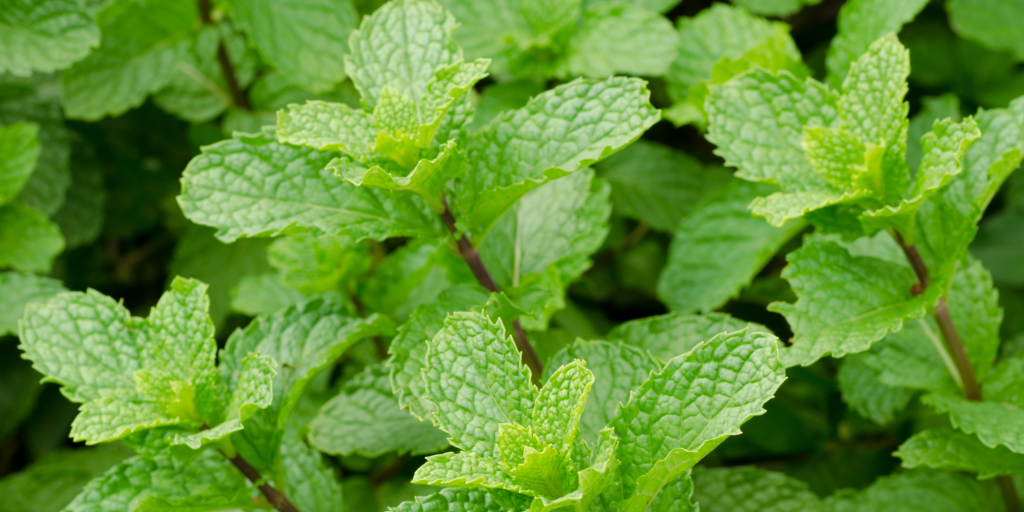
There’s nothing like the cool, tingly sensation of mint in the summertime, and peppermint is a plant powerhouse when it comes to skin care!
A natural astringent, mint can help brighten and tone your skin, reduce excess oil, and visibly tighten pores. It has antioxidant and antimicrobial properties, and has also been shown to reduce inflammation. Mint even has some anti-aging effects!
DIY Ritual: Mint Face Mask
With just a few ingredients, this mask soothes, hydrates, and gently exfoliates.
1. Blend a handful of fresh mint leaves with a healthy spoonful of plain yogurt and a spoonful of honey.
2. Apply a thin layer to clean skin and let it work its magic for 5 to 10 minutes.
3. Rinse, pat dry, and and follow with your favourite moisturizer. Enjoy your refreshed, healthy glow!
3. Lavender (Lavandula angustifolia)
Calms, Firms, and Supports Collagen Production
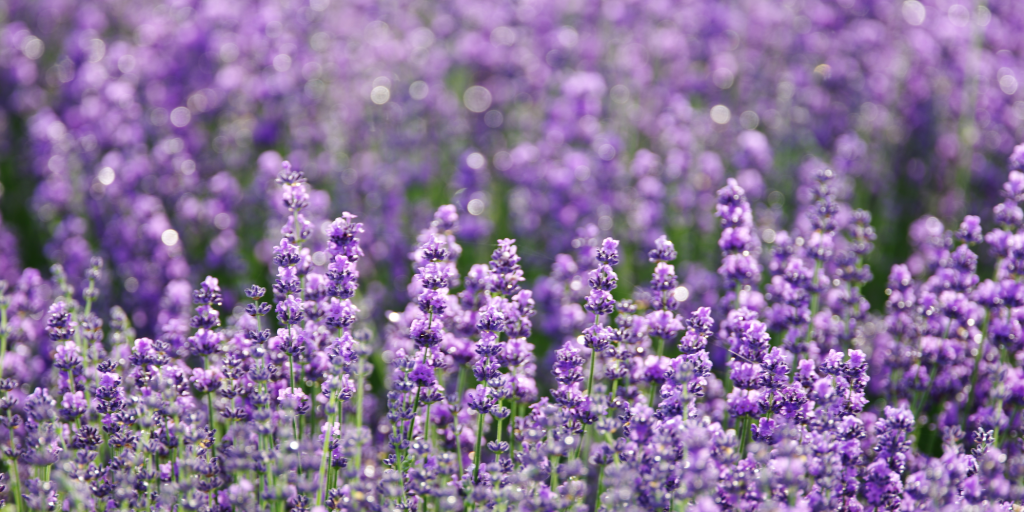
Commonly used in aromatherapy for its calming properties, lavender is also incredible for skin!
This herbal highflier is anti-inflammatory and packed with antioxidants that help fight free radical damage. Lavender has even been shown to support collagen production — meaning it helps support skin healing and regeneration, increase firmness, and reduce the look of fine lines.
DIY Ritual: Make your Own Lavender Face Oil
A deeply soothing oil you can make with just two ingredients!
1. Place a handful of dry lavender (stems, flowers, and leaves) into a clean glass jar.
2. Fill the jar with a skin-loving carrier oil like jojoba oil, avocado oil, or grapeseed oil.
3. Put the lid on and shake it up!
4. Place the jar in a window and let it sit for several days to a week, shaking gently every day. As it infuses, the oil will start to smell amazing!
5. Strain out the plant matter and put your lavender-infused oil into a dark bottle.
6. Apply a small amount to clean skin for a calming, nourishing boost!
4. Chamomile (Matricaria chamomilla)
Soothes, Calms, and Reduces Redness
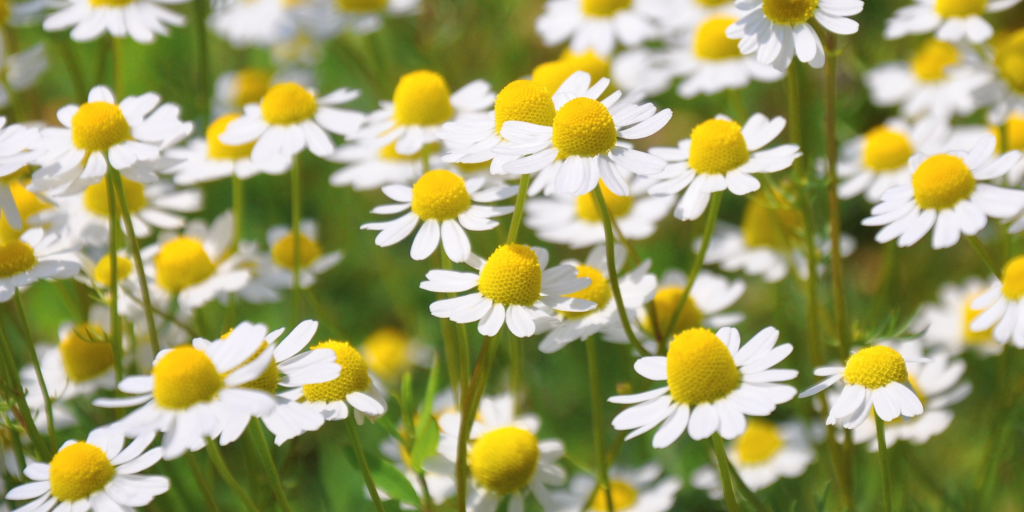
Another herbal remedy known for its calming properties, chamomile is like a lullaby for your skin.
Chamomile is anti-inflammatory and packed with antioxidants and flavonoids that help soothe inflamed skin, reduce the appearance of blotchiness, and even support healing. It’s especially helpful if your skin is sensitive, reactive, or prone to flare-ups.
DIY Ritual: Chamomile Compress
A gentle herbal hug for your face.
1. Steep 2–3 chamomile tea bags (or a few tablespoons of dried chamomile flowers) in hot water.
2. Let the concoction cool to a comfortable temperature.
3. Soak a clean cloth in the tea and squeeze out the excess.
4. Place the compress gently over your face or irritated areas for 5 to 10 minutes. Use this sweet self care time to relax and reflect!
5. Pat dry and follow with your favourite moisturizer.
5. Calendula (Calendula officinalis)
Heals, Soothes, and Hydrates
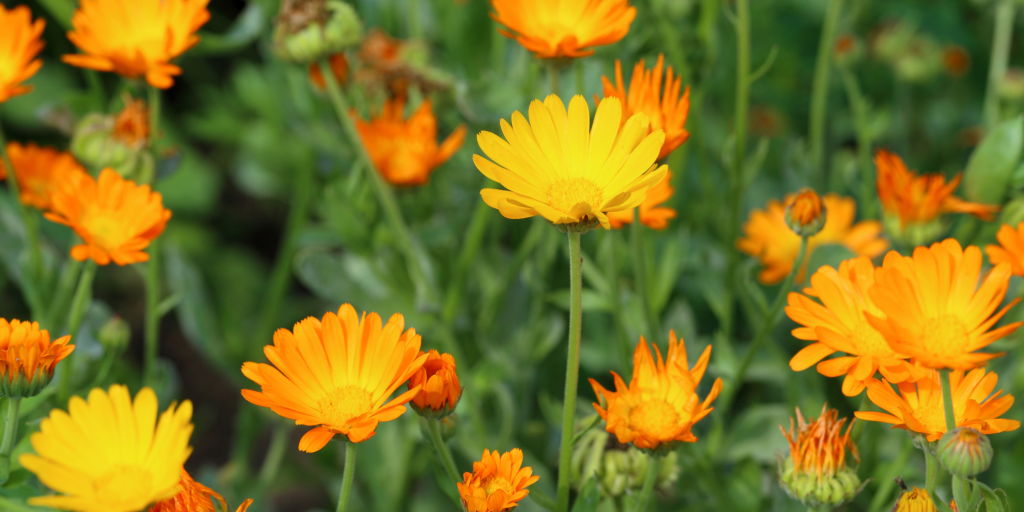
Calendula is a vibrant, sunny flower with serious skin healing properties. Often found in herbal formulas to help with eczema, this gentle yet powerful herb is especially loved by dry, sensitive, or acne-prone skin types.
In studies calendula has been shown to reduce inflammation and speed up wound healing, supporting the skin’s natural repair process.
DIY Ritual: Make your Own Calendula-Infused Oil
1. Add a handful of dried calendula petals to a clean glass jar.
2. Fill the jar with a carrier oil like jojoba oil, avocado oil, or grapeseed oil, covering the petals completely.
3. Put the lid on and shake it up!
4. Put the jar in a window and let it sit for 1 to 2 weeks, shaking gently every day.
4. Strain out the petals and store your calendula-infused oil in a dark bottle.
5. Use it as a facial oil, a healing spot treatment, or even to soothe dry hands and cuticles
Takeaway
Plants truly are nature’s skincare secret! Many of our favourite herbs (and even a few backyard weeds!) have incredible properties. Whether you grow them yourself or pick them up at your local market, these 5 everyday herbs remind us that beauty doesn’t have to be complicated. With some knowledge and a few DIY recipes, you can unlock the potent benefits of these plants for your skin and spirit.
The takeaway? Next time you’re looking to refresh your glow, look to your garden!
A final note— as you work with these plants and give these rituals a try, remember that time spent on self care is always worthwhile ♥︎
With the right tools and rituals, glowing skin is well within reach— and facial acupuncture is a powerful next step. Ready to take your skincare deeper? Find a VMR Cosmetic Acupuncture practitioner near you.
**********
Eileen Fauster of Essential Balance is a Registered Acupuncturist and Registered Holistic Nutritionist who specializes in skin care. Eileen helps clients by using the Vienna Mei Ren non-surgical acupuncture facelift, which combines the best acupuncture needles and techniques with a beautifying skin rejuvenation regime.
* Resources:
Ghavami, T., Kazeminia, M., & Rajati, F. (2022). The effect of lavender on stress in individuals: A systematic review and meta-analysis. Complementary Therapies in Medicine, 68, 102832. https://doi.org/10.1016/j.ctim.2022.102832
Givol, O., Kornhaber, R., Visentin, D., Cleary, M., Haik, J., & Harats, M. (2019). A systematic review of Calendula officinalis extract for wound healing. Wound Repair and Regeneration, 27(5), 548–561. https://doi.org/10.1111/wrr.12737
Hudz, N., Kobylinska, L., Pokajewicz, K., Horčinová Sedláčková, V., Fedin, R., Voloshyn, M., Myskiv, I., Brindza, J., Wieczorek, P. P., & Lipok, J. (2023). Mentha piperita: Essential oil and extracts, their biological activities, and perspectives on the development of new medicinal and cosmetic products. Molecules, 28(21), 7444. https://doi.org/10.3390/molecules28217444
Kiełtyka-Dadasiewicz, A., & Kubat-Sikorska, A. (2018). Chemical diversity of mint essential oils and their aromatherapy significance. Archives of Physiotherapy and Global Researches, 22(4), 53–57. https://doi.org/10.15442/apgr.22.4.6
Sah, A., Naseef, P. P., Kuruniyan, M. S., Jain, G. K., Zakir, F., & Aggarwal, G. (2022). A comprehensive study of therapeutic applications of chamomile. Pharmaceuticals, 15(10), 1284. https://doi.org/10.3390/ph15101284
Samuelson, R., Lobl, M., Higgins, S., Clarey, D., & Wysong, A. (2020). The effects of lavender essential oil on wound healing: A review of the current evidence. The Journal of Alternative and Complementary Medicine, 26(8), 680–690. https://doi.org/10.1089/acm.2019.0286
Sarikhani, M., Deylam, M., Alizadeh, E., Hejazy, M., Alizadeh-Salteh, S., Moeini, H., & Firouzamandi, M. (2021). Anti-aging effects of peppermint (Mentha piperita L.) and Shirazi thyme (Zataria multiflora Boiss.) plant extracts. Food Bioscience, 41, 100930. https://doi.org/10.1016/j.fbio.2021.100930
Silva, G. L., Luft, C., Lunardelli, A., Amaral, R. H., Melo, D. A., Donadio, M. V. F., Nunes, F. B., Azambuja, M. S., Santana, J. C., Moraes, C. M. B., Mello, R. O., Cassel, E., Pereira, M. A., & Oliveira, J. R. (2015). Antioxidant, analgesic and anti-inflammatory effects of lavender essential oil. Anais Da Academia Brasileira de Ciências, 87(2 suppl), 1397–1408. https://doi.org/10.1590/0001-3765201520150056
Srivastava, J. K., Shankar, E., & Gupta, S. (2010). Chamomile: A herbal medicine of the past with bright future. Molecular Medicine Reports, 3(6), 895–901. https://doi.org/10.3892/mmr.2010.377
Tafrihi, M., Imran, M., Tufail, T., Gondal, T. A., Caruso, G., Sharma, S., Sharma, R., Atanassova, M., Atanassov, L., Valere Tsouh Fokou, P., & Pezzani, R. (2021). The wonderful activities of the genus Mentha: Not only antioxidant properties. Molecules, 26(4), 1118. https://doi.org/10.3390/molecules26041118
von Schoen-Angerer, T., Deckers, B., Henes, J., Helmert, E., & Vagedes, J. (2018). Effect of topical rosemary essential oil on Raynaud phenomenon in systemic sclerosis. Complementary Therapies in Medicine, 40, 191–194. https://doi.org/10.1016/j.ctim.2017.10.012

